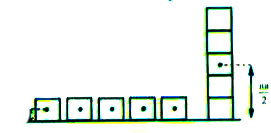N similar slabs of cubical shape of edge b are lying on ground. Density of material of slab is p. Work done ot arrange them one over the other is -
 Solution in Gujrati
Solution in Gujrati
(N2−1)b3pg
(N−1)b4pg
1/2(N2−N)b4pg
(N2−N)b4pg
The correct Answer is:C
Step by step video & image solution for N similar slabs of cubical shape of edge b are lying on ground. Density of material of slab is p. Work done ot arrange them one over the other is - by Physics experts to help you in doubts & scoring excellent marks in Class 12 exams.
Updated on:21/07/2023Topper's Solved these Questions
- TEST PAPERBOOK - ALLEN CHAPTER - TEST PAPEREXERCISE - PHYSICS
4 Videos
- TEST PAPERBOOK - ALLEN CHAPTER - TEST PAPEREXERCISE - PHYSICS
4 Videos
- SIMPLE HARMONIC MOTIONBOOK - ALLEN CHAPTER - SIMPLE HARMONIC MOTIONEXERCISE - Example
1 Videos
- TEST PAPER 1BOOK - ALLEN CHAPTER - TEST PAPER 1EXERCISE - PHYSICS
11 Videos
Similar Questions
Choose the correct statement:
View SolutionChoose the correct statement:
View SolutionA rod with rectangular cross section oscillates about a horizontal axis passing through one of its ends and it behaves like a seconds pendulum, its length will be
View SolutionWhy are electric field lines perpendicular at a point on an equipotential surface of a conductor ?
View SolutionTwo slabs A and B of equal surface area are placed one over the other such that their surfaces are completely in contact The thickness and coefficient of thermal conductivities of slab A is twice that B The first surface of slab A is maintained at 100∘C while the second surface of slab B is maintained at 25∘C The temperature at the contact of their surfaces is .
View Solutionn' identical cubes each of mass 'm' and edge 'L' are on a floor. If the cubes are to be arranged one over the other in a vertical stack, the work to be done is
View SolutionThere are two infinite slabs of charge, both of thickness d with the junction lying on the plane x = 0. The slab lying in the range 0 lt x lt d has a uniform charge density +ρ and the slab lying in the region – d lt x lt 0 has uniform charge density −ρ. Find the Electric field everywhere and plot its variation along the x axis. Note: This can be used to model the variation of electric field in the depletion layer of a p – n junction.
View SolutionTwo slabs A and B of equal surface area are placed one over the other such that their surfaces are completely in contact. The thickness of slab A is twice that of B. The coefficient of thermal conductivity of slab B is maintained at 25∘C. The temperature at the contact of their surface is
View SolutionThe work done in placing the dielectric slab inside one of the capacitors as shown in diagram
View SolutionTwo slabs A and B of equal surface area are placed one over the other such that their surface are completely in contact. The thickness of slab A is twice that of B. The coefficient of thermal conductivity of slab A is twice that of B. The first surface of slab a is maintained at 100∘C, while the second surface of slab B is maintained at 25∘C. The temperature at the contact of their surface is
View SolutionA composite slab consists of two slabs A and B of different materials but of the same thickness placed one on top of the other. The thermal conductivities of A and B are k_(1) and K_(2) respectively. A steady temperature difference of 12^(@)C is maintained across the composite slab. If k_(1) = K_(2)//2 , the temperature difference across slab A will be:
View Solutionn transparent slabs are arranged one on top of each other. The refractive indices of the material of the slabs are mu_(1),mu_(2),mu_(3) ***, mu_(n) and the thickness are t_(1),t_(2),t_(3), ***t_(n) . An image is formed at a particular position when a point object is seen perpendicularly through this combination of slabs. If the image is formed at the same position when seen through a single glass slab instead of the combination of slabs, what is the equivalent refractive index of the new glass slab?
View SolutionIf n number of identical cubes, each of mass m and side a lying on level ground. Find the work done in piling them one above the other.
View SolutionCan a slab of p - type semiconductor be physically joined to another n type semiconductor slab to form p -n junction ? Justify your answer.
View SolutionWhy can't we take one slab of p-type semiconductor and physically join it to another slab of 1-type semiconductor to get p-n junction ?
View SolutionConsider ..n.. number of indentical cubes each of mass ..m.. and side ..a.. lying on a level ground. Find the work done in piling them one above the other.

View Solution
